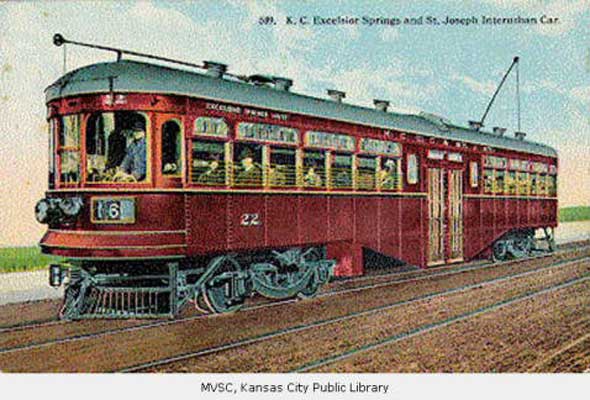
The history of Kansas City streetcars is on display in an online exhibit at the Kansas City Public Library website. It traces the beginning of streetcars in 1870 through the last Midtown run in 1957. This postcard depicts the Interurban Railway Car which transported people to Excelsior Springs and St. Joseph. Photo courtesy Missouri Valley Special Collections, Kansas City Public Library, Kansas City, Missouri.
It started in 1870 as horses pulled streetcars on tracks, went to cables pulling streetcars and soon to the electric streetcars that thrived for decades and suddenly died.
As Kansas City starts work on a two-mile streetcar system – its first in 56 years – people can look back on its history of public transportation.
The Kansas City Public Library has an online photography exhibit at its website with a brief written history of the growth and end of public rail.
That end came on June 23, 1957, when the Country Club line made the last streetcar run through Midtown.
People had protested and signed petitions trying to save that last remaining line. But cars, buses, highways and changing habits ended that round of public rail here and in many other cities.
But in 1900, electric streetcars thrived on more than 100 miles of track in the Kansas City area. Their popularity continued to grow and reached St. Joseph, Lawrence and Leavenworth.
Separate from the exhibit, a book by Monroe Dodd called A Splendid Ride gives a far more detailed account:
In 1902, people made about 57 million trips a year on Kansas City streetcars and about five billion nationwide. By 1923, that rose to 135 million in the city and 14 billion nationwide.
Kansas City also never racially segregated its streetcars and voted down one known attempt to do so.
The 1930s and the depression greatly reduced riders. Buses could run in 1935 for from 15 to 17 cents a mile and streetcars cost from 22 to 27 cents. Streetcars could hold more passengers but usually did not except at rush hours.
Economics shifted briefly in the 1940s when World War II led to rationing of gasoline and tires. Streetcar ridership surged to almost its peak in the early 1920s.
After the war, Detroit started churning out cars, while houses and stores spread to suburbs and better roads and highways were built. People took to cars. Ridership of both streetcars and buses fell and transit companies started shifting to the cheaper buses.
In 1956, streetcars ran for the last time on Troost Avenue, which had long been the most heavily traveled line in the city. To mark that, the 31st Troost and Linwood Merchants Association held a street festival with parades, prizes and dancing.
The book tells how Mayor H. Roe Bartle announced that it was time for buses.
“Tonight we go to a more modern form of transportation,” he told the crowd.
The next year, soon after the last Country Club line run, there was one more ceremonial streetcar run, from 48th and Harrison streets along Rockhill Road to 43rd and Main streets.
Dood’s book tells how City Manager L.P. Cookingham, a streetcar enthusiast, was aboard then and made a comment to a Kansas City Star reporter.
“Ah, how I hate to see them disappear,” Cookingham said.



Who’s talking